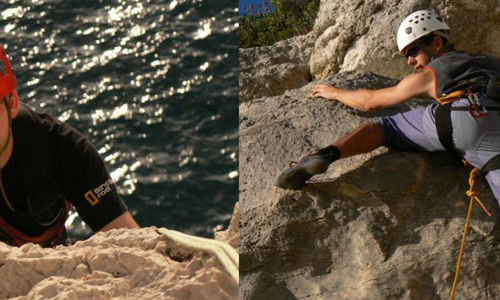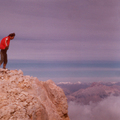
Stress Corrosion Cracking Failture of Climbing Anchors

It is out there, lurking in the places you enjoy most, the places where you feel safest. This menace strikes in broad daylight, it cannot be seen and its attacks cannot be predicted. Those who have experienced an attack are awed and humbled. Science has a complicated explanation for it. But who will stop it?
Does this sound like a grade B horror movie? Well, this movie is playing out at popular climbing areas around the world. And the menace? It’s stress corrosion cracking and corrosion.
Recent incidents indicate unexpected failures of climbing anchors under low loads and after only some months/years in place. These failures occurring mostly on stainless (!) steel anchors are due to environmental degradation, i.e. corrosion and more specifically stress corrosion cracking (SCC).
● In worst cases, anchors can break under only a few tens of kilograms – less than the climber weight.
● Usually along sea sides but can be some kilometers away from the coast. ● Corrosion is not always visible. Could be invisible cracks.
● Stress corrosion cracking, which is the most virulent, could initiate cracks very rapidly after anchor installation. Within some weeks maybe, a few months for sure.
● All stainless steels, even the 316L grade, are concerned.
● The UIAA Safety Commission is working on finding anchors with material suitable for these environments.
● All material in place shall be considered as potentially affected.
● The most critical factors are: ○ “Moderate” relative humidity location (very dry is OK, and very humid also, in between is a problem).
○ Area NOT washed by rain (even washed by the sea can be OK!!).
○ Temperature is not critical, SCC can occur at 20°C, but higher temperatures are worse.
○ Rock types: limestone/dolomite is generally worse than sandstone or granite (Karst is the worst case).
Stress corrosion cracking (SCC) has been confirmed as the cause of a number of recent climbing anchor (bolt) failures and is further suspected in many more incidents.
Such SCC induced failures may occur within a few months or years of installation, under loads as low as body weight, in stainless steel anchors—even 316 grade steel.
Evaluating the risk due to SCC is difficult for individual climbers because SCC degradation is often not visible. Nor is SCC easy to predict as it depends on a complicated set of factors, especially: high acidity & temperature, low humidity, and unwashed, magnesium rich rock.
Small differences in microclimate can lead to SCC degradation for some bolts, while other bolts on the same climb are unaffected. SCC is associated with seaside climbing but can also occur in inland areas where corrosive elements are present, either naturally occurring in the rock itself or deposited inland by sea breezes. In response to the challenges presented by SCC degradation of climbing anchors, this document outlines management strategies for individual climbers, bolters, climbing organizations, manufacturers and the International Climbing and Mountaineering Federation (UIAA).
Locations where stress corrosion cracking has been confirmed or is highly suspected
Thailand
Greece
Taiwan
Italy
Dominican Republic
Malta
Cayman Brac
Minorca
Hawaii
Morocco
Madagascar
Portugal
Sardinia
Factors contributing to stress corrosion cracking of climbing anchors
Concentration of chloride
Magnesium chloride, calcium chloride, sodium chloride
Chloride deposits containing salts with high solubility can be formed.
Temperature
NOT any cut-off/”safe” level, but above 30°C is worse
SCC could start at 20°C, a higher temperature increase the cracking speed; the temperature of a bolt in the sun can be significantly higher than the ambient air temperature.
Humidity
Low relative humidity, between 20% and 70%.
RH close to the deliquescence point of the chloride solution poses a significant danger of SCC.
Location – coastal / wind from the sea
Next to the sea up to 30 km from the coast?
There is no clear limit; winds from the sea with significant salt concentration can travel hundreds of km inland.
Washed by rain or not
Not washed by rain.
The absence of washing allows the chloride to concentrate locally on anchors. rock type limestone or dolomite Probably because of its high calcium and magnesium content.
Stresses
High tensile stress.
Ffrom manufacturing, due to rolling, bending, cutting, drilling, and welding. From installation, due to tightening, gluing. From plastic deformation; hard falls, hammering during installation, etc. From use, due to multiple hard falls.
Material – which stainless steel alloy
1.4301 (304), 1.4306 (304L), or lower resistance to SCC.
1.4401 (316) and 1.4404, 1.4435 (316L) are susceptible to SCC on the basis of the latest published work.
What You Should Know as Climber
Only destructive testing can confirm the presence/absence of SCC on installed anchors. It is not possible to visually assess or even to casually test (like to pull on them) the effective strength of the anchors in place. Even anchors that have been installed in recent months and/or look brand new could be compromised by SCC or some forms of corrosion. Tests done by a Petzl France on all bolts of an example cliff show that 20% of the installed anchors had a strength between 1 and 5 kN and thus would barely sustain body weight, let alone the mildest of fall arrests. Such conditions lead to incidents like the one that recently occurred in Sicily: during rappelling, the lower bolt of the belay broke under only the body weight of the climber (65 kg); fortunately the upper bolt held and the three climbers were unharmed.
Recommendations for climbers
When planning a trip
● Consider SCC when assessing the risk of climbing at a proposed climbing destination.
● Check with local climbers and/or climbing organizations regarding the prevalence of SCC and the corrosion resistance of local bolts.
● Be prepared for the presence of SCC, especially at hot, seaside, limestone/dolomitic destinations (Karst is the most aggressive rock).
When climbing
● Consider SCC when assessing the risk of climbing a given route.
● Belay/lower from redundant, multi-bolt anchors.
● Back up bolts and belay/rappel stances with nuts, camming devices, trees, and/or threaded hourglasses.
● Be prepared to abandon projects with suspect bolts.
In the event of bolt failure (once the climbers are safe and injuries have been attended to)
● Collect the failed anchor parts; avoid disturbing the failure surface or trying to piece together the failed anchor.
● Inform the local climbing community.
● Contact the UIAA, anchors@theuiaa.org and make the failed anchor parts available to the UIAA or one of its national federations for analysis.
WHAT YOU SHOULD KNOW WHEN INSTALLING BOLTS
● Until testing is complete and the corrosion standard is finalized, the UIAA Safety Commission recommends only Titanium grade 2 for locations that where SCC has been common.
● For areas with rare incidence of SCC or areas where SCC is suspected but not documented, anchors made from high-end High Corrosion Resistance (HCR) stainless steels may be used (MORE INFORMATION ON THESE ANCHORS AND MATERIALS WILL BE RELEASED SOON).
● 316(L) or 304(L) is NOT appropriate for any area where SCC has been documented or is suspected.
● Use of 316L grade or better alloy for corrosion resistance is recommended for all outdoor anchor components in locations where SCC has never been documented and there is no reason to suspect its presence.
● Use a calibrated torque wrench to fasten the nut in order to avoid plastic deformation of the material and to keep the axial stress at moderate levels, as suggested by the manufacturers.
● Inspect regularly, if possible every year, all the material in place.
● Please keep the UIAA informed: anchors@theuiaa.org WHAT CLIMBING ORGANIZATIONS SHOULD KNOW
● SCC and/or corrosion and the aging of existing bolts present challenges to the climbing community that cannot be met by individual climbers.
● The main obstacles to use of SCC and/or corrosion resistant anchors are cost and availability. Individual bolters are usually short of funds, and somewhat reluctant to spend even more of their own money than they’ve thought was necessary from past experience. If a bolting fund provides the funds, then the bolters are almost always happy to use more resistant anchors.
● This means that the bulk of the climbing population needs to start paying for anchors, whereas in the past most had a “free ride”.
● Bolting new climbs and re-bolting existing climbs to address the risks of both general corrosion and SCC will require significant investment of both time and money for the installation of new bolts that are appropriately corrosion resistant. This initial cost is offset by the increased lifespan of the resulting bolts and the decreased incidence of accident and injury.
● Quality control (QC) measures are necessary for responsible long term management of bolts, especially documentation of both anchor failures and anchor installation dates & types.
● Monitoring of bolt integrity (pull testing of off-route bolts) is similarly important. Record keeping for these QC measures must be in place for 50+ years.
Diskuse
Diskuze k článku

World Climbing nahrazuje IFSC
Dolomity a Julské Alpy 2025
Nejčtenější články

Střední Čechy AKTUÁLNĚ 2025

Žaloba: horolezec nechal umřít přítelkyni na Grossglockneru

Sasha DiGiulian Becomes First Woman to Free Climb Platinum - Longest Route on Yosemite’s El Capitan

Vysoké Tatry AKTUÁLNĚ 2025

Kleiner Lafatscher (Riesen)Verschneidung: skutečná klasika v Karwendelu
Regiony
Kalendář akcí Zobrazit všechny akce
| AKCE | KDE | INFO | KDY | ČAS |
|---|---|---|---|---|
| Svatý Jan - konec lezení | Křížová stěna | Povolené lezení 1.7.-31.12. | 31.12. | |
| Vakantie - veletrh | Nizozemsko, Utrecht | 8.-11.1. | 8.1. | |
| Eisfestival - ledové lezení | Rakousko, Matrei | 10.-12.1. | 10.1. | |
| Pro Winter - veletrh | Itálie, Bolzano | 11.-13.1. Horské technologie | 11.1. | |
| Ferienmesse - veletrh | Rakousko, Vídeň | 15.-18.1. | 15.1. | |
| Skialpuj Fest | Pec pod Sněžkou | 15.-18.1. | 15.1. | |
| Matka - veletrh | Finsko, Helsinky | 16.-18.1. Cestovní ruch | 16.1. | |
| Steel | Kladno, Polygon | 16.-18.1. Průmyslové lezení | 16.1. | |
| Boot - veletrh | Německo, Düsseldorf | 17.-25.1. | 17.1. | |
| CMT - veletrh | Německo, Stuttgart | 17.-25.1. | 17.1. |
Diskuse
| děláte to dobře | Kouďalo, 16.12.2025 10:47, 1 příspěvek |
| Hmm turecké hospodářství | Honza, 15.12.2025 14:16, 3 příspěvky |
| WC | Novinář, 15.12.2025 9:46, 2 příspěvky |
| Inu | Honza, 15.12.2025 8:41, 2 příspěvky |
| Karwendel Gut | Pišišvor, 14.12.2025 22:03, 2 příspěvky |
| Kontakt na farmu | Horydoly, 11.12.2025 0:06, 10 příspěvků |
| Kontakt na farmu | Bára Zemanová, 10.12.2025 22:12, 10 příspěvků |
| hrozný | Paulse, 10.12.2025 14:37, 1 příspěvek |
| Hmm turecké hospodářství | Horydoly, 9.12.2025 16:04, 3 příspěvky |
| mám e-longboard | Skiák, 9.12.2025 15:59, 5 příspěvků |
Fórum Zobrazit všechny příspěvky
| S.Pellegrino oznamuje dlo... | Horydoly , 15.12.2025 20:21 |
| Jižní Čechy nabízí origin... | Horydoly , 15.12.2025 12:49 |
| Třeboňská nocturna | Horydoly Open, 10.12.2025 11:14 |
| Advent v Muzeu Olomouckýc... | Horydoly , 9.12.2025 23:04 |
| Cyklistické závody 2026 | Horydoly , 9.12.2025 11:59 |
| Přihlaste se na veletrh c... | Horydoly , 2.12.2025 14:36 |
| Horský festival Expedície... | Horydoly , 1.12.2025 13:45 |
| Horský festival Expedície... | Horydoly , 1.12.2025 13:44 |
 VIDEO
VIDEO FACEBOOK
FACEBOOK TWITTER
TWITTER INSTAGRAM
INSTAGRAM PINTEREST
PINTEREST ENGLISH
ENGLISH








